|
Sea Cucumbers in the marine aquarium are valuable. They perform a valuable task by feeding. They sift through the sand bed removing decaying organic matter (called Detritus). Since high Nitrate issues in an aquarium are for the most part a function of detritus in the sand bed, by eliminating the detritus your aquarium's Nitrates will be at a lower, safer level. A secondary benefit of Sea Cucumbers in the saltwater aquarium is through the sea cucumbers sifting for Detritus, they aerate and oxygenate the sand bed.
|
Bright Pink Spiny Sea Cucumber
Pentacta anceps
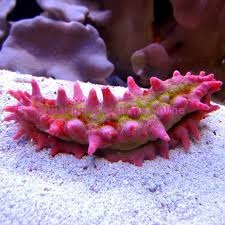
Description:
The Pink Spiny Sea Cucumber is a beautiful marine species. It is an attractive pink and yellow with colourful feeding tentacles which are withdrawn when either out of the water or feels threatened. Unlike most other sea cucumbers, once the Pink Spiny finds a location with suitable flow it stays put, extending the beautiful pink and yellow tentacles and begins to filter feed.
Diet and Feeding:
The Pink Spiny Sea Cucumber feeds by catching their food particulates trapped in the water column. The particulates are then brought to the mouth and ingested. Best to feed with either zooplankton or other liquid invertebrate foods. Daily feedings are recommended.
Reef Compatibility:
Excellent will not harm inverts or corals
Level of Care:
Easy
Approximate Purchase Size:
2 inches
|
Price Each $17.99
Pack of 3 $51.00
|
Australian Sea Apples
Pseudocholochirus
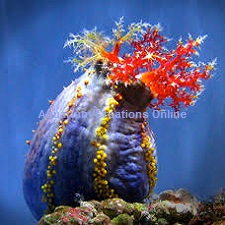
Description:
Their bright coloration and unique shape make Australian Sea Apples very attractive. The body of the Australian Sea Apple, is light to dark blue, and it has red feet. The tentacles are violet, blue, red, yellow and sometimes white. This a beautiful species that will add a new dimension of color to the reef aquarium. Be sure to have a large established reef aquarium with both suitable space and solid quantities of copepods and other microorganisms suitable for filter feeding invertebrates. Being a filter feeding species the Australian Sea Apple requires moderate to strong currents within the aquarium.
Diet and Feeding:
Australian Sea Apples are filter feeders, which extend their tentacles into the water current to filter out their food. As the food is trapped within the tentacles it is then drawn back into the mouth. In the aquarium environment, it is necessary to provide liquid foods, brine shrimp or grated mussel. Typically Australian Sea Apples are fed 3 times a week, but this will vary with the availability of food sources in the individual reef aquarium.
Reef Compatability:
Excellent will not harm inverts or corals
Level of Care: Sea Apples have the possibility to releases toxins (venom) that may poison fish in smaller aquariums when they are severely stressed or damaged by pump intakes or overflows. The chances of this happening are very rare unless damaged by pump intakes or overflow boxes. Do not keep any Sea Apple with any fish that would pick on on the tentacles of the Australian Sea Apple. These fish include; Butterflyfish, Large Angels, and any species that is listed not safe with invertebrates.
Acclimation Note:
Be sure to acclimate with the drip acclimation method explained in our on-line acclimation procedures. This is recommended to minimize exposure to fluctuating water parameters.
Approximate Purchase Size:
3" to 5"
Caution: Species can secrete or release toxins when stressed or injured that may kill saltwater fish in the aquarium. Aquariumcreationsonline.net cannot accept responsibility for any loss that may occur should this animal poison the aquarium.
|
Price Each $89.99
|
Assorted Fancy Colored Florida Cucumbers
Holothuria floridana
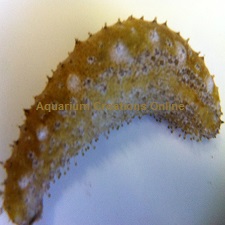
Description:
The Florida Sea Cucumber is an excellent worker, scouring the substrate for detritis and organic matter. Also known as the Caribbean Sea Cucumber, they haves highly variable colouration and patterns with various shades and combinations of white, brown, black and yellow. Holothuria cucumbers are often known as "sand-sifting" or "sand-mopping" cucumbers. While other types of cucumbers extend feeding oral tentacles into the water to catch free-floating plankton, the Holothuria floridana cucumbers move along the bottom and use their sticky oral tentacles like mops to collect detritus, bacteria, microalgae and other food particles. Many will burrow into the substrate or extend their bodies out from the protection of rockwork to feed. Recommended Qty is (1) per 50 gallons. Multiple cucumbers can often deplete small aquariums of their food source and lead to the cucumbers starving unless fed heavily.
Diet and Feeding:
Besides keeping your tank immaculate while it feeds, if algae levels are insufficient supplement their diet with dried seaweed called Nori, algae pellets, or algae waffers. As with all invertebrates, they do not tolerate copper-based medications and extreme fluctuations in water parameters.
Reef Compatability:
Excellent
Level of Care:
Easy
Approximate Purchase Size:
2"
|
Price Each $7.49
Pack of 3 $20.99
|
Sea Cucumber, Tiger Tail
Holothuria (Thymiosycia) impatiens
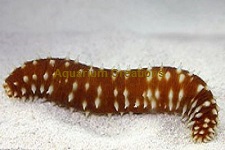
Description:
Native to the oceans of the Indo-Pacific, an excellent detrivore cleaner that shows little preference for substrate types, makes it an ideal choice for the aquarium. Being one of the most active species of cucumbers, the Tiger Tail Cucumber does a great job of cleaning detritus in the reef aquarium. The natural diet of the Tiger Tail Sea Cucumber consists of diatoms, microalgae, bacteria, meaty foods, and other detritus. It's a terrific scavenger keeping its posterior end firmly anchored in a crack or underneath a rock, it sweeps the surrounding substrate and algae-covered rocks with the front third of its body. The tentacles grab the detritus, sand, gravel and algae that it encounters and pushes them into its mouth. It then processes this material in its gut and expels the inedible fragments through its anus.
Tank Requirements:
The Tiger Tail Sea Cucumber needs to be in a large marine system with good size sand bed and caves for shelter. The Tiger Tail in the home aquarium will max out somewhere around 12" to 18" long. General rule is to keep up to 3 inches of worm for every 20 gallons of aquarium water.
Diet and Feeding:
The natural diet of the Tiger Tail Sea Cucumber consists of diatoms, microalgae, bacteria, meaty foods, and other detritus. If the aquarium is lacking in their natural diet, feed a frozen diet labeled for omnivores, which includes both algae and meaty items.
Reef Compatability:
Excellent will not harm inverts or corals
Level of Care: Easy
Approximate Purchase Size:
3" to 8"
|
Price Each $23.99
Pack of 2 $45.99
|
Yellow Knobby Sea Cucumber
Colochirus robustus
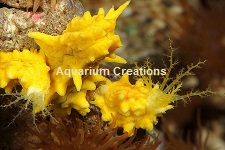
Description:
The Yellow Knobby Cucumber, Colochirus robustus is a beautiful addition to the home aquarium. Originating from the Indian Ocean the Bright Yellow Knobby body is an amazing aquarium sight. Most of the time you will see it feeding with bright yellow feathery tentacles that feed from the water column. A filter feeding sea cucumber similar to a Sea Apple, be sure you have an established reef aquarium with both suitable space and solid quantities of copepods and other microorganisms suitable for filter feeding invertebrates. Being a filter feeding species the Yellow Knobby Sea Cucumber requires moderate to strong currents within the aquarium. If a grouping of Yellow Knobby Sea Cucumbers are kept together spawning in the home aquarium is possible. They also can reproduce by dividing into 2 individuals.
Diet and Feeding:
The diet of a Yellow Knobby Sea Cucumber is liquid or dried phytoplankton and zoo plankton along with frequently stirring the substrate to releasing bacteria and detritus into the water for the Yellow Knobby to feed off of. If you notice your Yellow Knobby Sea Cucumber getting smaller in size it means its not being fed enough and you need to increase the feedings.
Reef Compatability:
Excellent will not harm inverts or corals
Level of Care: Moderate
Approximate Purchase Size:
1/2" to 2"
|
1/2" to 2" $19.99
|
Pink and Black Sea Cucumber
Holothuria edulis
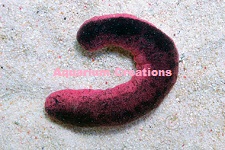
Description:
The Pink & Black Sea Cucumber is an excellent super cleaner for the reef aquarium. This pink and black sea cucumber inhabits shallow waters: inner and outer reef flats, back reef areas, coastal lagoons, barrier reefs, sandy and muddy areas, rubble-filled patches, and seagrass beds, where it feeds on detritus, diatoms, and scraps of meaty foods from the sand. One Pink & Black Sea Cucumber is sufficient for a 60 gallon aquarium. Maximum size of the pink and black sea cucumber is 12 inches. One Pink and Black Sea Cucumber will keep up to a 60 gallon aquarium's sand bed clean.
Diet and Feeding:
Provide the Pink & Black Sea Cucumber with plenty of sand bed to sift through. The natural diet of the Pink and Black Sea Cucumber consists of diatoms, microalgae, bacteria, meaty foods, and other detritus. If the aquarium is lacking in their natural diet, feed daily a frozen diet labelled for omnivores, which includes both algae and meaty items.
Reef Compatability:
Excellent will not harm inverts or corals
Level of Care: Moderate
Approximate Purchase Size:
4" to 6"
|
$34.99
|
|






